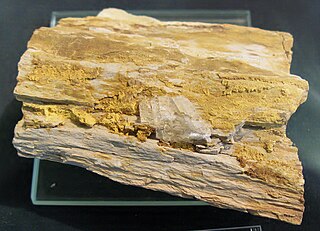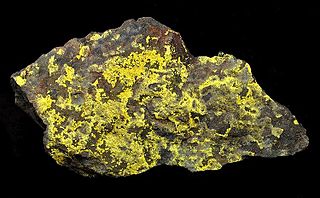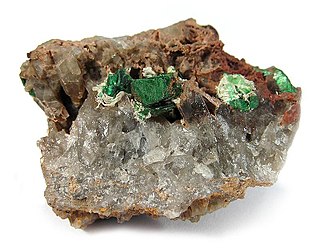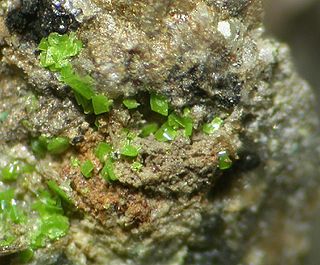
Gadolinite, sometimes known as ytterbite, is a silicate mineral consisting principally of the silicates of cerium, lanthanum, neodymium, yttrium, beryllium, and iron with the formula (Ce,La,Nd,Y)2FeBe2Si2O10. It is called gadolinite-(Ce) or gadolinite-(Y), depending on the prominent composing element. It may contain 35.5% yttria sub-group rare earths, 2.2% ceria earths, as much as to 11.6% BeO, and traces of thorium. It is found in Sweden, Norway, and the US.

Carnotite is a potassium uranium vanadate radioactive mineral with chemical formula K2(UO2)2(VO4)2·3H2O. The water content can vary and small amounts of calcium, barium, magnesium, iron, and sodium are often present.

Mimetite is a lead arsenate chloride mineral (Pb5(AsO4)3Cl) which forms as a secondary mineral in lead deposits, usually by the oxidation of galena and arsenopyrite. The name derives from the Greek Μιμητής mimetes, meaning "imitator" and refers to mimetite's resemblance to the mineral pyromorphite. This resemblance is not coincidental, as mimetite forms a mineral series with pyromorphite (Pb5(PO4)3Cl) and with vanadinite (Pb5(VO4)3Cl). Notable occurrences are Mapimi, Durango, Mexico and Tsumeb, Namibia.

Tyuyamunite (pronounced tuh-YOO-ya-moon-ite) is a very rare uranium mineral with formula Ca(UO2)2V2O8·(5–8)H2O. It is a member of the carnotite group. It is a bright, canary-yellow color because of its high uranium content. Also, because of tyuyamunite's high uranium content, it is radioactive. It was named by Konstantin Avtonomovich Nenadkevich, in 1912, after its type locality, Tyuya-Muyun, Fergana Valley, Kyrgyzstan.

Tokyoite is a rare barium manganese vanadate mineral with the chemical formula: Ba2(Mn3+,Fe3+)OH(VO4)2. It is the manganese analogue of the iron rich gamagarite and the barium analogue of the lead vanadate, brackebuschite.

Descloizite is a rare mineral species consisting of basic lead and zinc vanadate, (Pb, Zn)2(OH)VO4, crystallizing in the orthorhombic crystal system and isomorphous with olivenite. Appreciable gallium and germanium may also be incorporated into the crystal structure.

Volborthite is a mineral containing copper and vanadium, with the formula Cu3V2O7(OH)2·2H2O. Found originally in 1838 in the Urals, it was first named knaufite but was later changed to volborthite for Alexander von Volborth (1800–1876), a Russian paleontologist.
Lyonsite (Cu3Fe+34(VO4)6) is a rare black vanadate mineral that is opaque with a metallic lustre. It crystallizes in the orthorhombic crystal system. Lyonsite often occurs as small tabular typically well formed crystals. Lyonsite has a good cleavage and a dark gray streak.

Wakefieldite is an uncommon rare-earth element vanadate mineral. There are four main types described of wakefieldite- wakefieldite-(La), wakefieldite-(Ce), wakefieldite-(Nd), and wakefieldite-(Y), depending upon the dominant rare-earth metal ion present. Wakefieldite has a Mohs hardness ranging from 4 to 5. Wakefieldite forms crystals of tetragonal structure. In terms of crystal structure, it is the vanadate analog of the rare-earth phosphate mineral xenotime. Unlike xenotime, it is more favorable for wakefieldite to contain the lighter rare-earth elements over the heavier ones. Due to the lanthanide contraction, the heavier rare earths have smaller ionic radii than the lighter ones. When the phosphate anion is replaced by the larger vanadate anion, the tetragonal crystal system preferentially accommodates the larger light rare-earth elements.

Wakefieldite-(La) is the lanthanum analogue of the uncommon rare-earth element vanadate mineral Wakefieldite. It is a member of the xenotime group.
Wakefieldite-(Nd) is the neodymium analogue of the uncommon rare-earth element vanadate mineral wakefieldite. It is a member of the xenotime group.

Tsumebite is a rare phosphate mineral named in 1912 after the locality where it was first found, the Tsumeb mine in Namibia, well known to mineral collectors for the wide range of minerals found there. Tsumebite is a compound phosphate and sulfate of lead and copper, with hydroxyl, formula Pb2Cu(PO4)(SO4)(OH). There is a similar mineral called arsentsumebite, where the phosphate group PO4 is replaced by the arsenate group AsO4, giving the formula Pb2Cu(AsO4)(SO4)(OH). Both minerals are members of the brackebuschite group.

Vanuralite is a mineral of uranium with chemical formula: Al(UO2)2(VO4)2(OH)·11(H2O). It has yellow crystals and a Mohs hardness of 2. The name comes from the composition of the mineral.

Tangeite, also known as calciovolborthite, is a calcium, copper vanadate mineral with formula: CaCu(VO4)(OH). It occurs as a secondary mineral that can be found in sandstone and also in the oxidized zones of vanadium bearing deposits.
Aradite is a very rare mineral with formula BaCa6[(SiO4)(VO4)](VO4)2F. Aradite and its phosphorus-analogue, zadovite, were found in paralavas (rocks formed due to pyrometamorphism) of the Hatrurim Formation. Both aradite and zadovite have structures similar to that of nabimusaite. Structure of all three minerals is related to that of hatrurite.
Zadovite is an extremely rare mineral with formula BaCa6[(SiO4)(PO4)](PO4)2F. Together with its vanadium-analogue, aradite, zadovite occur in paralavas (type of pyrometamorphic rocks). Both minerals have structures similar to nabimusaite, and these three minerals occur in the Hatrurim Formation of Israel. Structure of all three minerals is related to that of hatrurite. Minerals combining barium, phosphorus and silicon together are scarce.
Nabimusaite is a very rare mineral with formula KCa12(SiO4)4(SO4)2O2F. Its structure, as in case of similar aradite and zadovite, is a derivative of the one of hatrurite. Nabimusaite gives its name to the nabimusaite group. The mineral was found in a pyrometamorphic rock of the Hatrurim Formation, a site known for the natural pyrometamorphism. It is interpreted to have formed due to interaction of a precursor assemblage with sulfate-rich melt. Nabimusaite is potassium- and fluorine-analogue of dargaite.

Gottlobite, CaMg(VO4,AsO4)(OH), is a mineral found as isolated crystals or isometric grains of orange or orange-brown color. The size of the crystals are a half millimeter in diameter and are part of the orthorhombic crystal system. Gottlobite forms a solid solution with adelite, which is an end member composition of CaMg(VO4)(OH), as well as being classified in the adelite group. Gottlobite is also part of the vanadates and arsenates group. With these characteristics, it is similar to the minerals tangeite and austinite by X-ray diffraction methods.

Sengierite is a rare oxide and hydroxide mineral, chemically a copper and uranyl vanadate, belonging to the carnotite group. Its chemical formula is Cu2(OH)2[UO2|VO4]2·6H2O.
The xenotime group is a grouping of minerals containing anhydrous phosphates and vanadates.













